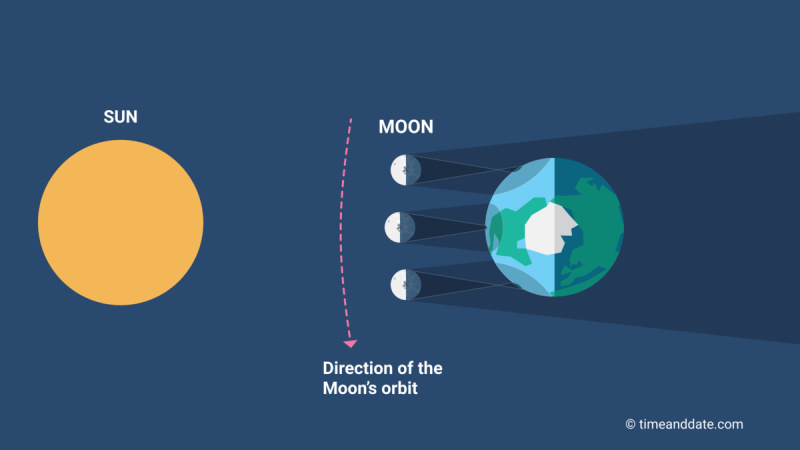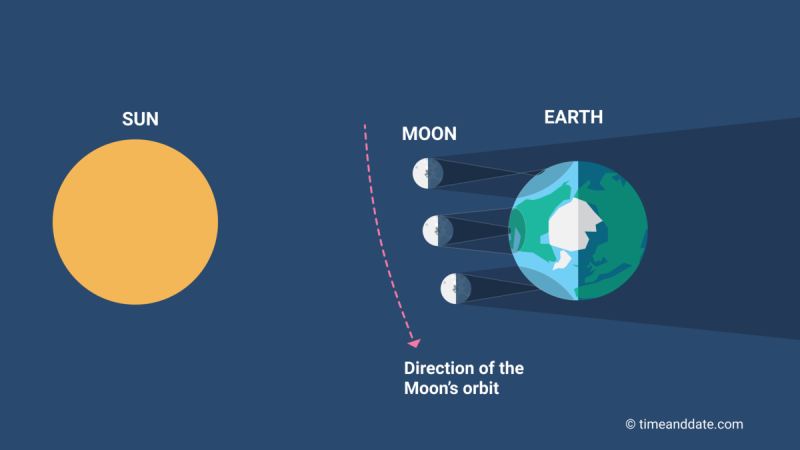
Konstantin Bikos posted this original article at timeanddate.com. Edits by EarthSky.
What is a hybrid eclipse?
A hybrid eclipse is a type of solar eclipse that looks like an annular solar eclipse or a total solar eclipse, depending on the observer’s location along the central eclipse path.
During a hybrid solar eclipse, Earth’s curvature brings some sections of the eclipse path into the moon’s umbra. The umbra is the darkest part of the moon’s shadow that creates total solar eclipses. Areas that remain outside the umbra’s reach see an annular eclipse or partial eclipse.
The April 20, 2023, solar eclipse is a hybrid eclipse. Observers in North West Cape, Australia, and parts of East Timor and the Indonesian province of West Papua will get to see totality.
Last chance to get a moon phase calendar! Only a few left. On sale now.
3 shadows, 3 eclipse types
A solar eclipse occurs when the moon’s shadow falls on Earth. The shadow consists of three areas: an umbra, a penumbra, and an antumbra. The type of eclipse we see depends on the part of the moon’s shadow we are in:
- The moon’s umbra, the shadow’s dark central portion, causes total solar eclipses. Here, the moon appears a little larger than the sun and covers it completely.
- The penumbra, the lighter, outer part of the shadow, creates partial solar eclipses. Here, the moon obscures only a part of the sun’s disk.
- The antumbra, a half-shadow that begins where the umbra ends, results in annular solar eclipses. During this type of eclipse, the moon looks a little smaller than the sun, so the edge of the sun’s disk remains visible around the moon.
Hybrid solar eclipses involve all three areas of the moon’s shadow and combine all three types of solar eclipses.

A hybrid eclipse is an annular-total combo
Since the moon’s umbra and antumbra are always surrounded by a penumbra, both total and annular solar eclipses look like partial solar eclipses if you’re just outside the path of the central shadow. The same is true for hybrid eclipses.
What is special about this type of eclipse? The full eclipse – the moment when the moon is positioned centrally in front of the sun – looks different depending on your location.
Some observers along the central shadow’s path see the same solar eclipse as a total solar eclipse with an eclipse magnitude greater than 1. Others experience it as an annular eclipse, which has a magnitude below 1. For this reason, hybrid eclipses are also called annular-total eclipses.
This may not sound so amazing until you realize that this variation is caused primarily by the Earth’s curvature. To understand this connection, let’s learn more about the moon’s shadows.
When umbra meets antumbra
Hybrid solar eclipses happen when Earth travels through the area where the moon’s umbra meets its antumbra.
Because the moon is smaller than the sun, both its umbra and its antumbra are V-shaped. The diameter of the umbra decreases with growing distance from the moon. Where the umbra ends, at the tip of the V, the antumbra starts. This part of the shadow increases in diameter as we move away from the moon. Together, both shadows look a bit like an hourglass, if viewed from the side (see illustration above).
The location where the umbra transitions into the antumbra marks the spot where, if you look at the sun and moon, the apparent sizes of both celestial bodies are exactly equal. If you move toward the moon from that spot, you enter the umbra and see a total solar eclipse. If you move away from the moon, you enter antumbral territory, so the moon begins to appear smaller than the sun, creating an annular eclipse.
Distance to the moon depends on location
If Earth was a flat wall facing the sun and moon, there would be no hybrid solar eclipses. The umbra and antumbra do not overlap. So, depending on the moon’s current distance, it would cast either its umbra or its antumbra on the Earth’s flat surface. Thus, it would create either a total or an annular solar eclipse.
However, since we live on a globe, the moon’s distance at any one moment differs from one place on the Earth’s surface to another. It’s smallest in locations where the moon is in the zenith position, meaning straight up. The lower the moon’s altitude, the larger its distance.
Imagine looking at the moon and Earth from space. The area of Earth that faces the moon directly, where the planet’s surface bulges toward the moon, is the location where the moon appears in the zenith position. It’s where the distance between the two celestial bodies is least. If you move away from that spot, Earth’s surface bends away from the moon, following the globe’s curvature in all directions, so the distance to the moon increases.

Earth’s curvature changes eclipse’s look
Since the moon’s umbra only covers a certain distance before turning into the antumbra, the Earth’s curvature can bridge the distance between the two shadows. When that’s the case, the moon’s umbra reaches areas facing the moon, creating a total solar eclipse there. In these places, the moon looks a little larger than the sun. Other areas – where the distance is larger – are just beyond the umbra’s reach. Here the antumbra can form, and the moon looks a little smaller than the sun, causing an annular solar eclipse.
Both the moon and Earth are in constant motion, so the moon’s shadow moves across Earth’s surface during a solar eclipse, generally from west to east. This means the eclipse begins as an annular eclipse in areas west of the spot that faces the moon. It then turns into a total solar eclipse as the shadow approaches that spot. Finally, it switches back again to an annular appearance as it moves away toward the east.
Moon’s distance can override Earth’s curvature
In rare cases, the ever-changing distance between Earth and the moon may break that pattern. If the distance increases or decreases by a certain amount during the event, this may counteract the distance-altering effect of Earth’s curvature enough to allow the moon’s umbra to also reach areas on Earth not facing the moon directly at the beginning or end of the event.
If the moon’s distance from Earth decreases, its apparent size increases. In that case, the hybrid solar eclipse starts as an annular eclipse and changes into a total eclipse without changing back into an annular eclipse at the end. The total eclipse continues because the smaller distance makes the moon look large enough to cover all of the sun’s disk. If the distance increases, the moon’s apparent size decreases. In that case, the appearance of the eclipse changes from total to annular but without the initial annular phase.
For example, during the hybrid solar eclipse on November 3, 2013, the moon’s distance decreased within the event. It started as an annular eclipse, which later transformed into a total eclipse. But it never changed back to an annular look in its last stages.

Why is a hybrid eclipse unusual?
The reason why hybrid solar eclipses are comparatively rare – they happen roughly once per decade – is that both the moon’s and sun’s distance to Earth have to be just right.
For example, if the total distance between the moon and Earth is comparatively small, only the moon’s umbra falls on Earth. This situation creates a total solar eclipse in all locations along the central shadow’s path. Annular solar eclipses happen when the moon is relatively far from Earth, so the antumbra forms before the shadow reaches Earth, even in locations facing the moon directly. The snag is that both the sun’s and the moon’s distance change continuously. Since the spectrum of distances required for a hybrid eclipse is so narrow, most eclipse configurations are unsuitable for this type of eclipse.
In mathematical terms, if you divide the distance between the sun and Earth during the eclipse by the distance between the moon and Earth, the result must be a number very close to 400 for a hybrid eclipse to occur.
What does a hybrid eclipse look like?
While hybrid solar eclipses represent an unusual and interesting type of eclipse on a global scale, they look like standard total, annular or partial eclipses, depending on the observer’s location.
However, since hybrid solar eclipses involve the thinnest parts of the moon’s umbra and antumbra, their main phase, where the moon is positioned centrally in front of the sun, is typically very short. As with total and annular eclipses, the sun appears partially eclipsed before and after the main phase of a hybrid eclipse.
Bottom line: A hybrid eclipse is a solar eclipse that appears as total for some observers and annular for others, with those farther from the centerline seeing a partial eclipse.
The post What is a hybrid eclipse? A total and annular combined first appeared on EarthSky.
0 Commentaires